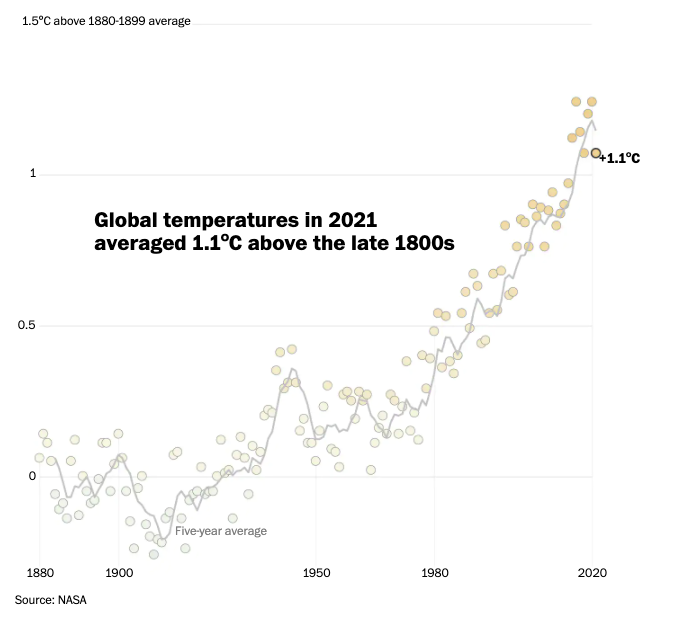The hottest seven years on record were the last seven
from Wapo
Global temperatures in 2021 were among the highest ever observed, with 25 countries setting new annual records, according to scientists from NASA, NOAA and Berkeley Earth

None of us will ever experience a year that cool again.

Despite a La Niña weather pattern in the Pacific Ocean, which tends to cool the planet, 2021 was roughly tied for sixth-hottest year ever observed, scientists say. All of the seven hottest years on record have happened in the last seven years.
The new global temperature data sets, which come from three of the world’s top climate research institutions, are packed with alarming signs of a world in crisis. More than two dozen countries that are home to about 1.8 billion people experienced their warmest years ever last year. July was the hottest month humanity has recorded. The heat dome that seared the Pacific Northwest this past summer was “the most anomalous extreme heat event ever observed on Earth,” in the words of one scientist — a disaster so severe that it would have been virtually impossible in a world without climate change.
Overall, last year did not smash as many global records — it ranked seventh lowest for Northern Hemisphere snow cover, ninth smallest for average Arctic sea ice extent and 10th highest for number of named tropical storms, depending on the data set consulted.
But the fact that 2021 didn’t rewrite the history books makes it even more sobering, said NASA climatologist Gavin Schmidt. It underscores the extent to which human greenhouse gas emissions, primarily from burning fossil fuels, have fundamentally and irrevocably changed the planet. Even the not-quite-so-bad years are dramatically worse than anything that could have been imagined a generation ago. Natural variation, like the cooling influence of La Niña, can barely put a dent in the relentless man-made warming trend.
The year 2021 was the seventh in a row in which global temperatures were more than 1 degree Celsius above the preindustrial average. It’s unlikely anyone alive will see the world’s temperature drop below that 1-degree benchmark again.
“There is no going back,” said Schmidt, director of the NASA Goddard Institute for Space Studies and a lead researcher on the agency’s annual temperature analysis. The roughly 1.5 trillion tons of carbon dioxide emitted by humans — more than half of it in the 34 years since Hansen’s testimony — will not leave the atmosphere for at least several more centuries.
Schmidt added: “We are reaping what we’ve sown.”
The three climate reports released Thursday, along with a fourth analysis from the European Union’s Copernicus Climate Change Service published Monday, differ slightly because they draw on different data sets. The European group ranked 2021 as the fifth-hottest year on record, just ahead of 2015 and 2018. NASA has the year tied for sixth with 2018, while Berkeley Earth researchers said it could fall anywhere between fifth and seventh.
“What really matters for the climate isn’t exactly where 2021 falls, it’s that it continues the extremely clear trend of very high temperatures,” said Zeke Hausfather, a climate scientist at the Breakthrough Institute and Berkeley Earth.
Since 1981, average global temperatures have increased at a rate of about 0.18 degrees Celsius (0.32 degrees Fahrenheit) per decade. In the same period, the warming of oceans — which have absorbed about 90 percent of the additional heat trapped by human carbon pollution — has gotten eight times faster. According to a new analysis published Tuesday in the journal Advances in Atmospheric Sciences, the oceans now contain more energy than at any point since record-keeping began.
On land, large swaths of East Asia, North and West Africa and the Middle East experienced their hottest years ever in 2021. China, South Korea, Bangladesh and Nigeria all notched record-high average annual temperatures. Canada set an all-time temperature record, hitting 49.6 degrees Celsius (121 degrees Fahrenheit) and breaking its previous high by almost five full degrees Celsius.

A record-warm year for a fifth of the planet’s population
Areas where 2021 was the warmest year on record: top five warmest
- China
- Iran
- Saudi Arabia
- Bangladesh
- Nigeria
Source: Berkeley Earth
Yet annual temperature records are just one measure of Earth’s altered climate. The consequences of human carbon emissions are even more visible — and more painful — in local and regional weather events.
“Global average temperature doesn’t kill anyone,” said Fredi Otto, an Imperial College London climate scientist and co-lead of the World Weather Attribution Network. “It is heat waves, it is heavy rainfall. The very high-impact events often are the extremes.”
In 2021, there were plenty of those. The United States endured at least 20 weather disasters costing $1 billion or more last year, the second most on record, NOAA announced this week. Hurricanes, wildfires, tornadoes and floods — almost all of them made worse by climate change — killed at least 688 people and caused at least $145 billion in damage.
A separate Washington Post analysis has found that more than 40 percent of Americans lived in a county affected by climate disaster in 2021 and 80 percent live someplace that experienced a multiday heat wave.
No continent was spared. Flash floods in central China, South Sudan and Germany killed hundreds of people and destroyed thousands of homes. Extreme drought destroyed crops from Iran to Kenya to Canada and Brazil. Typhoon Surigae, one of the strongest and earliest tropical cyclones on record, wreaked hundreds of millions of dollars in damage across Pacific island nations and Southeast Asia.
“Even the rate at which records are being broken is itself a record-breaking event,” Schmidt said. “These things are going to keep happening.”
Current policies and pledges put the planet on track to warm by about 2.5 degrees Celsius (4.5 degrees Fahrenheit) by the end of the century. At that level of warming, average sea levels would rise more than two feet. Warm spells would last twice as long and be at least 25 percent more frequent. Some 300 million additional people would suffer from water shortages, and another hundred million or so would experience severe floods each year.
Limiting warming to 1.5 degrees Celsius above preindustrial levels, the most ambitious goal of the Paris climate agreement, would dramatically lessen those impacts. But it requires humanity to take swift and dramatic action to curb planet-warming pollution. Scientists say the world can afford to emit less than 500 billion additional tons of carbon dioxide — about 11 years’ worth of current emissions — if we hope to meet that 1.5 C goal.
But the world is nowhere near on track. In the United States, emissions surged after coronavirus pandemic shutdowns, according to a new analysis from the Rhodium Group. Coal-fired electricity generation went up 17 percent — the first annual increase in reliance on America’s dirtiest fuel source in almost a decade. Despite a global agreement to strengthen near-term climate commitments at the COP26 talks in November, overall emissions are on track to keep rising for several more years.
“We are not where we need to be,” U.N. Environment Program Executive Director Inger Andersen said at the Glasgow, Scotland, conference last fall. “We need to step up with much more action, much more urgency and much more ambition.”



